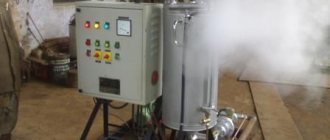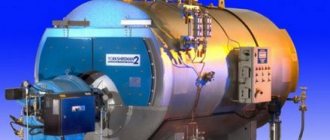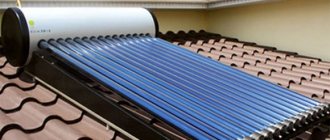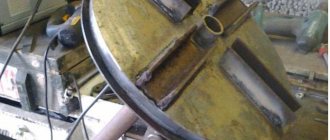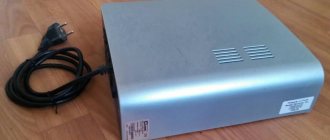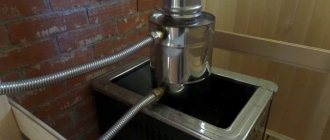Every person who uses electric heating in their home has encountered the fact that at the most necessary moment it can turn off . This problem is solved by uninterruptible power supplies - sources of electricity that work even when the full power supply is turned off. It is quite possible to not only purchase a UPS for heating systems in a store, but also make it yourself for your home, cottage or apartment, and below we discuss in detail how to do this.
Uninterruptible power supplies for a heating pump - how to make it yourself
A reliable heating system is one of the most important things in a private residential home. Its stable and correct operation is a guarantee of comfortable and safe living, since malfunctions in the heating system can cause serious damage to your home. Since certain problems often arise with the power grid, experts recommend using an uninterruptible power supply for the heating pump (UPS). The pump itself guarantees the normal movement of liquid through the pipes, prevents it from stagnating, and in a system with an uninterruptible power supply it will provide protection against voltage surges or power outages.
18650 battery and its varieties
The main element of the future uninterruptible power supply is a 18650 lithium-ion battery. In shape and size, it is similar to standard AAA or AA AA batteries.
The capacity of AA batteries ranges from 1600–3600 mAh. With an output voltage of 3.7 V.
There are several types of 1865 class batteries. The differences are only in chemical composition:
- Lithium Manganese Oxide.
- Lithium Cobalt Oxide.
- Lithium Iron Phosphate or Ferrophosphate).
All of them are successfully used:
- in phone chargers;
- in laptops;
- flashlights and so on.
What is an uninterruptible power supply for a heating pump?
All private residential buildings are equipped with an autonomous heating system, where gas and solid fuel boilers operate automatically. But during the cold season, power outages occur quite often.
To ensure that the heating system does not fail due to these circumstances and functions correctly for a long time, an uninterruptible power supply (UPS) should be used; it will not only ensure constant operation of the boiler, but will also protect its engine from negative consequences due to possible power outages . The system includes a unit that provides uninterruptible power supply, batteries of various capacities and a set of cables.
Why does a boiler need a UPS?
Typically heating systems use gas, solid or liquid fuel. However, for stable operation you need a current source that will work without interruption. If the power goes out, the furnace will turn off and the coolants will cool down. And if this happens frequently, due to constant temperature changes, cracks will begin to appear in the system, which will then only increase. All this leads to rapid wear and tear of the equipment.
Source ytimg.com
If you use electric heating in your home, then most likely you have encountered the problem that the light can turn off at the most necessary moment. To solve this problem, install an uninterruptible power supply - a device that serves as a power source even when the main power supply is turned off. You can buy it in a specialized store or make an uninterruptible power supply yourself.
As practice shows, a homemade device will cost you two times less than a purchased one, which is considered to be one of the main advantages of why it is worth making.
But keep in mind that without the appropriate skills, you can spend much more time and resources than professionals. Therefore, it is worth considering whether it would be advisable to independently manufacture such a device.
Necessity
If something extraordinary happens to the power line (breaks, accidents, etc.), the heating boiler stops working automatically. Such situations can not only damage the engine of a gas or solid fuel boiler, but also completely destroy the equipment.
The pump stops working, the coolant overheats, and the consequence could be a major accident in the heating system. The UPS will provide electricity not only to the pump, but also to the entire heating system. As a rule, an uninterruptible power supply is purchased to work with gas boilers, but boilers running on solid fuel can also fail as a result of interruptions in the electricity supply.
There are two types of uninterruptible heating pumps: linear and linear-interactive.
- Linear. These are the simplest devices of this type; they do not have a voltage stabilizer. If the equipment is disconnected from the power supply, it will automatically charge from the battery.
- Line-interactive, they are also called double conversion UPS. Such equipment is equipped with a system that stabilizes the voltage; it can be connected to a generator. Line-interactive systems monitor the battery charge level without intervention. If there is a power outage, the battery automatically starts up. When power is restored, the systems automatically resume normal operation. Line-interactive uninterruptible power supplies are more expensive.
The UPS charger is not designed for such a large battery capacity
The following often emerges from the previous point: since the UPS had a 7Ah battery out of the box, and now it’s installed at 70Ah, the charger will not be able to provide a large current and fully charge the battery. The statement is partly true, the charger in the UPS does have a limit on the maximum current with which it can charge the battery, but this does not mean at all that it will not be able to charge the battery. It will just increase the charging time. Of course, this can become a problem if electricity is provided on a schedule, several hours a day, and the batteries simply do not have time to charge. But in this case, nothing prevents you from connecting a more powerful charger (or a solar panel controller, for example) to the same battery in parallel with the UPS. The main thing to remember is that the instructions for the charger, inverter and UPS probably say that this cannot be done.
Advantages and disadvantages
The advantages of using a UPS include the following:
- the equipment ensures continuous operation of the pump, regardless of possible problems with the power supply;
- volatile devices are protected from network problems, the entire system works efficiently;
- ease of installation;
- convenience and reliability in use;
- absence of noise during equipment operation.
Disadvantages of using uninterruptible power supply:
- high level of electricity consumption from batteries;
- often encountered low power of chargers built into the UPS.
The UPS for powering the heating boiler must have a long reserve
For some reason, along with this point, a computer UPS of the type %Company% Back Power 500 is constantly cited, whose battery has a capacity of 7Ah, and the operating time of the batteries is specially limited by a jumper to 5 minutes, due to the fact that the transformer used during operation the batteries heat up so much that the plastic case is deformed. Despite this, even such a weak UPS can operate for a long time on batteries, you just need to replace the battery with a more capacious one and add active cooling. In my case, such a UPS worked from a car battery for 20 hours, supporting the operation of a PC with a consumption of around 150W. Simply put, the backup time does not depend on the UPS, but on the capacity of the batteries.
How to choose
When purchasing a UPS for a heating pump, you must consider the following nuances:
- Heating boiler power consumption. When choosing a UPS, the characteristics of the equipment with which it will work are first taken into account. To determine the power of the UPS, it is necessary to take into account the “starting torque” of the engine, since when the uninterruptible power supply is turned off, the power consumed by the engine invariably increases. If it is greater than the power of the UPS, the device will automatically stop working.
- UPS battery life. This value depends on the battery capacity. Experts advise choosing a UPS with external batteries connected. This will allow you to select the required number of batteries and ensure the required time of independent operation of the equipment. Devices with internal batteries are used less frequently because they cannot provide long-term backup power. Uninterruptible power supplies with internal batteries will ensure longer operation of the equipment in case of problems with the power supply. Models of this type are marked Long Time - “long time”.
- The time it takes for the equipment to go offline. The faster the power supply is restored, the less load will be on the main heating system.
- Output voltage parameters. They are indicated in the standard instructions attached to the device. You should choose a UPS with data - pure sine, other specified characteristics can lead to a malfunction of the entire system and even failure of the pump itself.
Correct phasing is necessary for correct power supply of the heating boiler
Now comes the fun part.
Boilers with automatic ignition have a flame sensor to turn off the gas if the lighter breaks and fails to ignite it. These sensors can be either mechanical (in the case of manually started boilers) or electrical, and in the second case they can respond to heating, radiation or ionization. And in the case of ionization flame sensors, problems arise when powering them from a UPS. In general, the problem can be solved very simply: you need to connect the zero before the UPS to the zero after the UPS. And it's all. True, there is one caveat: if the UPS is connected to the network with a plug, then it is advisable to connect the zero with a separate wire directly from the socket, because otherwise it is possible to insert the plug with the wrong side (you can, of course, put a small machine on the jumper between the zeros, but this will be more of a crutch than fix). And of course, it is assumed that if this is a private house, then it has a grounding loop and is connected to the neutral wire (to the RCD, if there is one), i.e. The zero has been re-grounded (if the circuit is not a TT!), and of course the boiler itself is grounded. After the UPS, the wire that performs the function of zero when powered from the mains is selected as a zero.
How to make an uninterruptible power supply - step-by-step instructions
First of all, it is worth understanding that it is quite possible to assemble a UPS yourself, but this will require certain knowledge. If a person does not have knowledge in this area, it is not worth creating an uninterruptible power supply with your own hands; time and money will be wasted.
In addition, it is worth understanding that a system created in this way will have a rather unpresentable appearance , it will lack a number of functions, and it will not work automatically, but in manual mode.
To create a UPS you will need:
- Inverter 12 to 220 volts. Inverters are different, they differ in power and shape of the output signal; in a particular case, you will need a device with a peak power of 600 W, and a working power of at least 300 W.
- Rechargeable batteries. The larger the battery capacity, the longer the uninterruptible power supply will work in offline mode. Equipment with a capacity of 45A/hour will work for approximately 8 hours, with a capacity of 95A/hour - a day. It is best to choose gel batteries; they last much longer, but are also more expensive.
- Battery charger. Of course, it must match the capacity of the battery itself.
The process of creating an uninterruptible power supply with your own hands can be divided into the following stages:
- There are two symbols + and - on the inverter; they must be connected with a powerful wire to the corresponding symbols on the battery.
- The boiler plug should be connected to the power supply on the inverter; after pressing the “turn on” button, the equipment will begin to work.
- The inverter and boiler are running, but the battery is gradually discharged. After the battery runs out or the power supply returns, you need to connect the charger to the battery.
It is worth paying attention to the following nuances during assembly:
- to fasten parts, use thick copper wires;
- the connections between the wires and the equipment must be very reliable, so they should be given special attention;
- connections should be checked after some time, since there is a risk of metal oxidation in these places, which can impair the operation of the system.
Formulation of the problem
I periodically thought about how to solve this problem and decided to make my own UPS with the following characteristics:
- Easy to develop, preferably using ready-made modules
- Inexpensive so that it can be placed near each router - Adjustable output voltage - you can power not only equipment with 12/24V - routers / switches, but also, for example, Intel NUC (it has 19V)
- The case size is no larger than that of hEX PoE for assembly as a “UPS+Router” module
Upon closer examination of the task and the entire “zoo” of equipment, I realized that hAP Lite is the weak link in the entire chain.
Firstly, it needs 5V (all others from 12 to 48), secondly, it has a micro-usb power connector and no PoE-in. Therefore, these devices were removed from the list of protected ones and when the EE is turned off, they “fall” as before. In the process of thinking about the circuit, I realized that it is better to use 12V as the base voltage of the battery, and then, if necessary, change the converters to step up or step down. This will make the UPS universal and will allow powering devices in the range from 1 to 48V, and will also reduce the cost of the device by reducing the number of batteries to 3x.
Possible problems in the operation of the uninterruptible power supply
During operation of the equipment, the following malfunctions may occur:
- contamination of the internal surface of the UPS, dust settling on it (especially during construction work indoors);
- Frequent overloads in the operation of an uninterruptible power supply can lead to the inverter failing;
- the end of the battery life (with long-term use of the device);
- The special lubricant on the cooling fans may dry out, which can also cause the device to fail.
Adviсe
When purchasing a UPS and putting the device into operation, it is also important to pay attention to the following points:
- There is no need to save on purchasing this equipment and choose a cheaper device; good quality batteries will ensure long autonomous operation of the UPS and increase its service life.
- The uninterruptible power supply is designed to be connected to a heating system; there is no need to connect other devices and devices to it, since its power is not designed for this.
- Experts advise purchasing models that work with phase-dependent equipment.
- It is better to install UPS in a basement or semi-basement, where they will not take up part of the living space. However, the device and batteries must be kept in a dry place to protect it from moisture. To do this, the equipment can be installed in a small cabinet, which will be hermetically and securely closed.
A constant supply of electrical energy will ensure full and efficient operation of the heating system. An uninterruptible power supply for a pump will be an excellent solution to problems associated with power outages. High-quality equipment is not cheap, however, these costs will quickly pay off, especially since installing a UPS will be less expensive than repairing or replacing the entire heating system.
Source of the article: https://homehill.ru/otoplenie/boiler/besperebojniki.html
Single-cycle generator - UPS
Circuit diagram of the simplest flyback converter:
This single-cycle converter is used in small power supplies, such as a phone charger.
Circuit of the simplest step-down transformer. Used in trucks for cigarette lighters with a voltage of 12 Volts. That is, where it is necessary to reduce the voltage from 24 V to 12 V. The second name of the single-ended converter circuit is the following: stabilizer with PWM modulation.
Also, such a scheme can be found in resource-intensive expansion cards, such as video cards. At maximum current there is a minimum of losses.
The main disadvantage of this circuit is that there is no protection against overloads, both current and voltage.
Types of uninterruptible power supplies for heating pumps
Linear uninterruptible power supply for heating pump
On the modern market, equipment for protecting heating boilers from power failures is presented in two types:
- Linear. The simplest equipment that does not have a voltage stabilizer. If there is a power failure in the electrical network, the heating devices begin to operate from the built-in batteries.
- Line-interactive uninterruptible power supplies. Unlike the previous ones, they are equipped with a built-in voltage stabilizer and can be connected directly to the generator. Line-interactive UPSs independently monitor the battery charge level. If there is no power in the electrical network, the equipment begins to operate on battery power; in normal mode, the batteries charge themselves.
Linear-interactive uninterruptible power supply for a heating pump
Both devices are connected to the electrical network on a permanent basis, due to this they ensure constant operation of the heating equipment.
It is better to connect batteries in parallel than in series
There is an opinion that it is better to take a UPS with a 12V battery voltage and connect several batteries in parallel to increase the total capacity than to take a 24/48V UPS and connect the same batteries in series. As an argument, the need to balance batteries is usually given if they are connected in series, but what is overlooked is that each battery consists of 6 elements, balancing of which, in principle, is not provided for by the design of the battery, and yet it still works somehow. In my case, 4 12V batteries are connected to two UPSs; after two years of use, the difference in battery voltage was less than a tenth of a volt.
Features and disadvantages of equipment
The main advantages of uninterruptible power supplies for the circulation pump and heating system include:
- Ensuring continuous and uninterrupted operation of heating equipment regardless of the performance of the electrical network.
- Efficient operation of the entire system even during power failures.
- Simple installation that does not require specific skills.
- Convenient to use.
- Increased equipment reliability.
- The UPS does not produce any extraneous noise during operation.
- Batteries discharge too quickly when there is no mains power.
- Some inexpensive equipment has low power, and therefore cannot cope with the load.
The result of the work
The design power of the uninterruptible power supply is a quarter ampere. Ideally, it should be enough to operate the router for 2.5 hours.
But from the measurements it turns out that if a homemade UPS for a home consumes a current of 1 Ampere, the new device will last for 30 minutes.
If the router “eats” 0.5 Amperes, then the battery power will last for about an hour and a half.
This device can ensure uninterrupted operation of other devices. For example, such as:
- routers;
- wireless phone docking stations;
- hard disks.
How to purchase a suitable uninterruptible power supply
When purchasing an uninterruptible power supply for a heating boiler, you need to pay attention to the following parameters:
- What power output is required for the normal operation of the heating boiler used in your home . When choosing a UPS, be sure to take into account the operating parameters of the heating equipment; the “starting moment” when power consumption is maximum deserves special attention. If the uninterruptible power supply does not meet the required parameters, the heating device will automatically stop working.
- Offline operating time. This value directly depends on the number of batteries in the UPS and their capacity. Experts advise giving preference to equipment in which you can connect the batteries yourself. This way you can choose the optimal number of batteries depending on the required operating time of the heater during periods of no power. When choosing devices with built-in batteries, be sure to pay attention to the “Long Time” marking. This means that the heater will operate without power for a long time.
- The time it takes for the uninterruptible power supply to switch to offline mode. This parameter indicates the time period during which the UPS is able to start operating on batteries in the event of a power outage.
- Output voltage. It is better to give preference to uninterruptible power supplies for protection against power surges, which are marked “Pure sine”; otherwise, the heating boiler may fail during network problems.
Testing the device under load
Now that the device is assembled and we know how it works, we need to remember what we can power from it.
The most important thing is to remember what current consumption this device can provide. In the circuit I use a 3A converter. The discharge current of an 18650 battery is usually equal to two times the capacity (if we do not consider high-current ones). Thus, when using a battery with a capacity of 2000 mA, they are capable of delivering current up to 4A. However, it is worth remembering that if we doubled the output voltage on the DC/DC converter, for example, we power the equipment from 24V with a current of 1A, then the current to the converter will also double and the batteries will supply a charge with a current of 2A.
Accordingly, it is better to remember this pattern:
- 12V – 3A
- 24V – 1.5A
- 48V – 0.75A
We carry out a load test and determine the battery life.
The UPS is equipped with a 2000 mA GoPower battery. Output voltage – 12V. There are 3 devices connected to the UPS - hEX PoE to which, in turn, CSS106-5G-1S and 951Ui-2HnD are connected via PoE-out. Traffic on the network continues to run when the input power is turned off.
In total, the total consumption of all devices was about 0.55-0.65A (changed during the measurement process). CSS106-5G-1S – ±185mA, 951Ui-2HnD – ±280mA plus own consumption hEX. Before shutting down, this assembly worked for 2 hours 15 minutes
, while the residual voltage on the three batteries was 6.5V. It was not possible to discharge more strongly; the deep discharge protection on the 3S module worked. The temperature of the batteries did not change, which indicates an insignificant load during the discharge process.
Do-it-yourself uninterruptible power supply for a pump
We assemble the UPS with our own hands
Before you start assembling, it is worth remembering that it is quite possible to assemble an uninterruptible power supply with your own hands, however, you must have certain knowledge in this area. If you do not understand anything about the principle of operation of a UPS and other network elements, you should not start creating a device yourself - you will just waste your money and time (there is also a high probability of heating equipment being damaged when using an incorrectly assembled uninterruptible power supply).
Nuances of filter assembly
To monitor the stability of the device, a harmonious system for voltage filters will help you. You can do it yourself by finding a proven scheme, or order it from professionals if you are not confident in your abilities. Such filters consist of various transformers, resistors and other additional devices.
If you have assembled the filter system correctly, then your system will stabilize any source of electrical current. It will not be difficult to assemble it, but to do this, follow the following diagram:
Source radiostorage.net
The main problem is in calculating the parameters. And the contour elements are easy to calculate and make, but they are assembled in different ways - one parallel, the other sequential. Regardless of the assembly method, tune to 50 Hz.
You will need to calculate the parameters of the inductors for the core, and in the core you need to make a gap between the turns.
Use the following formulas:
- Gap in millimeters: number of turns * max. current in amperes * 1.257E-3
- Number of turns: core cross-sectional area in square millimeters * max. current in amperes * inductance of the inductor in H * 1.257E6 - round the result up
- For a series circuit: the maximum current in amperes is 1.4 * {load power, W} / 220 V.
- For a parallel circuit: the maximum current in amperes is 1.4 * 220 V / 28 * {signal frequency, Hz - 50 Hz} * {inductance of the choke, H}.
Source habrastorage.org
Common UPS Problems
Problematic uninterruptible power supply board
When using the device to ensure uninterrupted power supply to a heating boiler, the following problems may arise:
- Contamination of the surface of the uninterruptible power supply, dust settling, which can lead to improper operation of the device (this problem often occurs if the device is installed in a room where construction work is being carried out).
- If the power supply frequently experiences voltage surges, the inverter may fail.
- After many years of use, rechargeable batteries become damaged (they charge slowly or do not charge at all, and quickly lose their charge).
- The grease on cooling fans requires constant replacement. Over time, it hardens and causes the cooling system to malfunction, eventually causing the UPS to completely fail.
Essentials
Everything you need for a homemade UPS is on the Ali Express trading platform:
- A pair of batteries for a 18650 series screwdriver.
- Built-in charge indicator.
- Converter board.
- Charging board.
- Power adapter 9 V 2 A.
- Plastic housing.
Full set of parts:
Tips for choosing a suitable uninterruptible power supply
When purchasing an uninterruptible power supply device and using it, you should pay attention to the following points:
- Forget about saving on UPS. Cheaper devices often do not perform as advertised and have a limited service life. In addition, such devices often fail to cope with the functions assigned to them and ultimately lead to the failure of the entire heating system (the rule applies: the miser pays twice).
- Uninterruptible power supplies for heating boilers are intended exclusively for connection to a pump. You should not connect other equipment to the device, since the power of the UPS is simply not designed for such experiments.
- Give preference to models that support work with phase equipment.
- The optimal location for installing an uninterruptible power supply is considered to be a basement or semi-basement in a private house. There, devices will not occupy living space. Please remember that the device must be protected from high humidity. Compliance with all parameters is made possible by using a small cabinet that will be hermetically sealed.
Please note that you should only buy high-quality equipment. It will cost an order of magnitude more than its Chinese counterparts, but the money invested will quickly pay off. Remember that installing a high-quality uninterruptible power supply will in any case be less expensive than repairing or replacing an autonomous heating system in the house.
Source of the article: https://fortvideo.ru/articles/besperebojnik-dlya-nasosa-otopleniya
Price overview
To make it easier to choose and buy an uninterruptible power supply for a gas boiler or electric boiler, we have prepared a table that shows the cost and cities of Russia, Ukraine and Belarus:
| City | Price, rubles | City | Price, rubles |
| Moscow | 35 000 | Kyiv | 30 000 |
| Minsk | 30 000 | Saint Petersburg | 33 000 |
| Odessa | 35 000 | Voronezh | 30 000 |
| Volgograd | 30 000 | Ekaterinburg | 30 000 |
| Vologda | 25 000 | Ulyanovsk | 25 000 |
| Tyumen | 30 000 | Astrakhan | 30 000 |
| Barnaul | 27 000 | Belgorod | 27 000 |
| Bryansk | 25 000 | Gomel | 30 000 |
| Dnepropetrovsk | 30 000 | Donetsk | 25 000 |
| Rostov-on-Don | 30 000 | Kazan | 25 000 |
| Kaluga | 25 000 | Krasnodar | 30 000 |
| Lipetsk | 25 000 | Lugansk | 20 000 |
| Nizhny Novgorod | 30 000 | Novorossiysk | 20 000 |
| Novosibirsk | 20 000 | Kirov | 25 000 |
| Orenburg | 27 000 | Penza | 30 000 |
| Permian | 30 000 | Ryazan | 30 000 |
| Samara | 25 000 | Saratov | 30 000 |
| Stavropol | 30 000 | Syktyvkar | 25 000 |
| Smolensk | 30 000 | Tver | 30 000 |
| Tomsk | 30 000 | Tula | 30 000 |
| Ufa | 30 000 | Kharkiv | 25 000 |
| Khabarovsk | 30 000 | Cheboksary | 25 000 |
| Chelyabinsk | 27 000 | Baltaysk | 25 000 |
| Krasnoyarsk | 30 000 |
For sale in professional equipment stores in St. Petersburg or Moscow, there are any UPS models apc, Forte, inelt, ippon, Navien, Leoton and others. Naturally, a Russian UPS will cost an order of magnitude cheaper than a similar imported brand.

